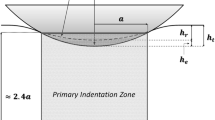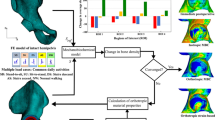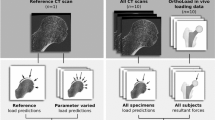Abstract
Finite element (FE) analysis provides an useful tool with which to analyze the potential performance of implantations in a variety of surgical, patient and design scenarios. To enable the use of FE analysis in the investigation of such implants, models must be experimentally validated. Validation of a pelvic model with an implanted press-fit cup in terms of micromotion and strain is presented here. A new method of micromotion has been introduced to better describe the overall movement of the cup within the pelvis. The method uses a digitizing arm to monitor the relative movement between markers on the cup and the surrounding acetabulum. FE analysis was used to replicate an experimental set up using a synthetic hemi-pelvis with a press-fitted all-metal cup, subject to the maximum loading observed during normal walking. The work presented here has confirmed the ability of FE models to accurately describe the mechanical performance of the press-fitted acetabulum and surrounding bone under typical loading conditions in terms of micromotion and strain distribution, but has demonstrated limitations in its ability to predict numerical micromotion values. A promising digitizing technique for measuring acetabular micromotions has also been introduced.









Similar content being viewed by others
References
Abdul-Kadir, M. R., U. Hansen, R. Klabunde, D. Lucas, and A. A. Amis. Finite element modelling of primary hip stem stability: the effect of interference fit. J. Biomech. 41:587–594, 2008.
Adler, E., S. A. Stuchin, and F. J. Kummer. Stability of press-fit acetabular cups. J. Arthroplasty 7:295–301, 1992.
Anderson, A., C. Peters, B. Tuttle, and J. Weiss. Subject-specific finite element model of the pelvis: development, validation and sensitivity studies. J. Biomech. Eng. Trans. ASME 127:364–373, 2005.
Baleani, M., R. Fognani, and A. Toni. Initial stability of a cementless acetabular cup design: experimental investigation on the effect of adding fins to the rim of the cup. Artif. Organs 25:664–669, 2001.
Bell, C. G., P. C. Weinrauch, R. W. Crawford, and M. J. Pearcy. Thermomechanical investigation of the cortical bone analogue in third-generation Sawbones femurs. Proc. Inst. Mech. Eng. H 221:213–217, 2007.
Bergmann, G., G. Deuretzbacher, M. Heller, F. Graichen, A. Rohlmann, J. Strauss, and G. N. Duda. Hip contact forces and gait patterns from routine activities. J. Biomech. 34:859–871, 2001.
Bragdon, C. R., D. Burke, J. D. Lowenstein, D. O. O’Connor, B. Ramamurti, M. Jasty, and W. H. Harris. Differences in stiffness of the interface between a cementless porous implant and cancellous bone in vivo in dogs due to varying amounts of implant motion. J. Arthroplasty 11:945–951, 1996.
Cristofolini, L., M. Viceconti, A. Cappello, and A. Tonib. Mechanical validation of whole bone composite femur models. J. Biomech. 29:525–535, 1996.
Curtis, M. J., R. H. Jinnah, V. D. Wilson, and D. S. Hungerford. The initial stability of uncemented acetabular components. J. Bone Joint Surg. Br. 74:372–376, 1992.
Davies, J. Handbook of Materials for Medical Devices. Ohio: ASM International, 2003.
Heiner, A. D. Structural properties of fourth-generation composite femurs and tibias. J. Biomech. 41:3282–3284, 2008.
Hsu, J., K. Lai, Q. Chen, M. Zobitz, H. Huang, K. An, and C. Chang. The relation between micromotion and screw fixation in acetabular cup. Comput. Methods Programs Biomed. 84:34–41, 2006.
Kim, Y. S., T. D. Brown, D. R. Pedersen, and J. J. Callaghan. Reamed surface topography and component seating in press-fit cementless acetabular fixation. J. Arthroplasty 10:S14–S21, 1995.
Kluess, D., R. Souffrant, W. Mittelmeier, A. Wree, K.-P. Schmitz, and R. Bader. A convenient approach for finite-element-analyses of orthopaedic implants in bone contact: modeling and experimental validation. Comput. Methods Programs Biomed. 95:23–30, 2009.
Kwong, L. M., D. O. O’Connor, R. C. Sedlacek, R. J. Krushell, W. J. Maloney, and W. H. Harris. A quantitative in vitro assessment of fit and screw fixation on the stability of a cementless hemispherical acetabular component. J. Arthroplasty 9:163–170, 1994.
Massin, P., E. Vandenbussche, B. Landjerit, and B. Augereau. Experimental study of periacetabular deformations before and after implantation of hip prostheses. J. Biomech. 29:53–61, 1996.
Murray, D. W. The definition and measurement of acetabular orientation. J. Bone Joint Surg. Br. 75-B:228–232, 1993.
NJR. National Joint Registry for England and Wales 7th Annual Report. Hemel Hempstead, UK: National Joint Registry, 2010.
Perona, P. G., J. Lawrence, W. G. Paprosky, A. G. Patwardhan, and M. Sartori. Acetabular micromotion as a measure of initial implant stability in primary hip arthroplasty: an in vitro comparison of different methods of initial acetabular component fixation. J. Arthroplasty 7:537–547, 1992.
Pilliar, R., J. Lee, and D. Maniatopoulos. Observations on the effect of movement in bone ingrowth into porous-surfaced implants. Clin. Orthop. Relat. Res. 208:108–113, 1986.
Reggiani, B., L. Cristofolini, E. Varini, and M. Viceconti. Predicting the subject-specific primary stability of cementless implants during pre-operative planning: preliminary validation of subject-specific finite-element models. J. Biomech. 40:2552–2558, 2007.
Rodrigues, J., H. Lopes, F. de Melo, and J. A. Simões. Experimental modal analysis of a synthetic composite femur. Exp. Mech. 44:29–32, 2004.
Shirazi-Adl, A., M. Dammak, and G. Paiement. Experimental determination of friction characteristics at the trabecular bone/porous-coated metal interface in cementless implants. J. Biomed. Mater. Res. 27:167–175, 1993.
Spears, I. R., M. Pfleiderer, E. Schneider, E. Hille, G. Bergmann, and M. M. Morlock. Interfacial conditions between a press-fit acetabular cup and bone during daily activities: implications for achieving bone in-growth. J. Biomech. 33:1471–1477, 2000.
Viceconti, M., G. Brusi, A. Pancanti, and L. Cristofolini. Primary stability of an anatomical cementless hip stem: a statistical analysis. J. Biomech. 39:1169–1179, 2006.
Viceconti, M., R. Muccini, M. Bernakiewicz, M. Baleani, and L. Cristofolini. Large-sliding contact elements accurately predict levels of bone-implant micromotion relevant to osseointegration. J. Biomech. 33:1611–1618, 2000.
Won, C. H., T. C. Hearn, and M. Tile. Micromotion of cementless hemispherical acetabular components. Does press-fit need adjunctive screw fixation? J. Bone Joint Surg. Br. 77-B:484–489, 1995.
Yew, A., Z. Jin, A. Donn, M. Morlock, and G. Isaac. Deformation of press-fitted metallic resurfacing cups. Part 2: finite element simulation. Proc. Inst. Mech. Eng. H 220:311–319, 2006.
Zhang, Q.-H., J.-Y. Wang, C. Lupton, P. Heaton-Adegbile, Z.-X. Guo, Q. Liu, and J. Tong. A subject-specific pelvic bone model and its application to cemented acetabular replacements. J. Biomech. 43:2722–2727, 2010.
Zivkovic, I., M. Gonzalez, and F. Amirouche. The effect of under-reaming on the cup/bone interface of a press fit hip replacement. J. Biomech. Eng. Trans. ASME 132:041008, 2010.
Acknowledgments
The authors would like to thank the Engineering and Physical Sciences Research Council (EPSRC) and Finsbury Orthopaedics Ltd. for supporting this work.
Author information
Authors and Affiliations
Corresponding author
Additional information
Associate Editor Peter E. McHugh oversaw the review of this article.
Rights and permissions
About this article
Cite this article
Clarke, S.G., Phillips, A.T.M. & Bull, A.M.J. Validation of FE Micromotions and Strains Around a Press-Fit Cup: Introducing a New Micromotion Measuring Technique. Ann Biomed Eng 40, 1586–1596 (2012). https://doi.org/10.1007/s10439-012-0523-6
Received:
Accepted:
Published:
Issue Date:
DOI: https://doi.org/10.1007/s10439-012-0523-6




